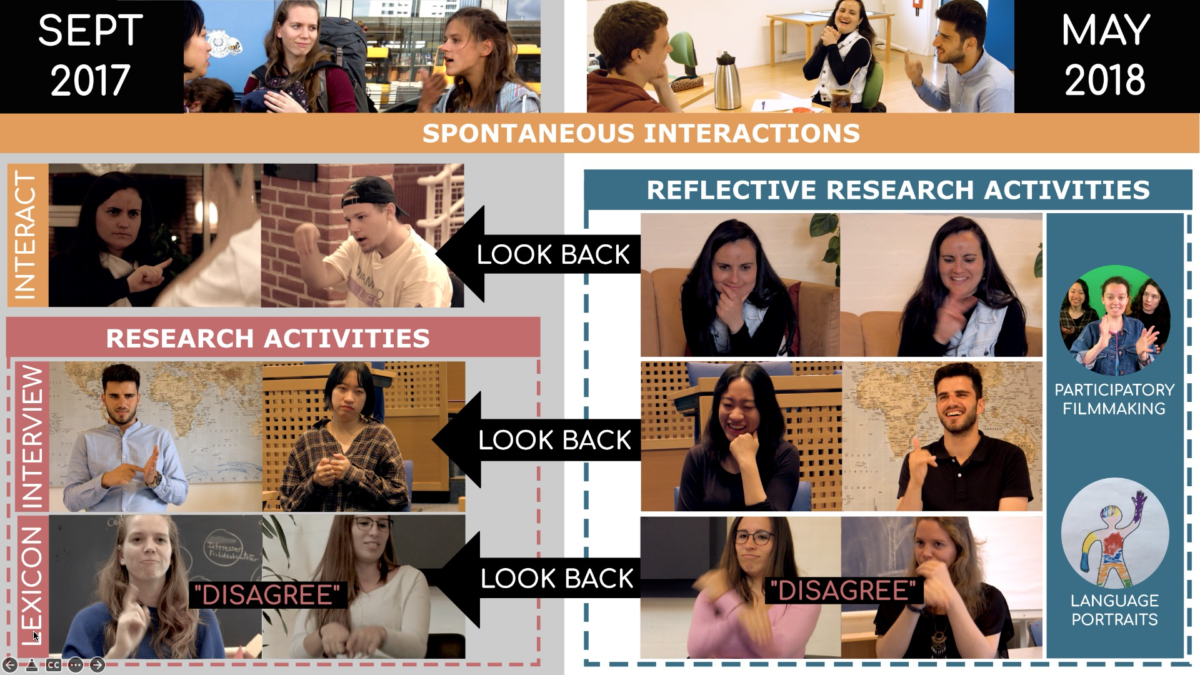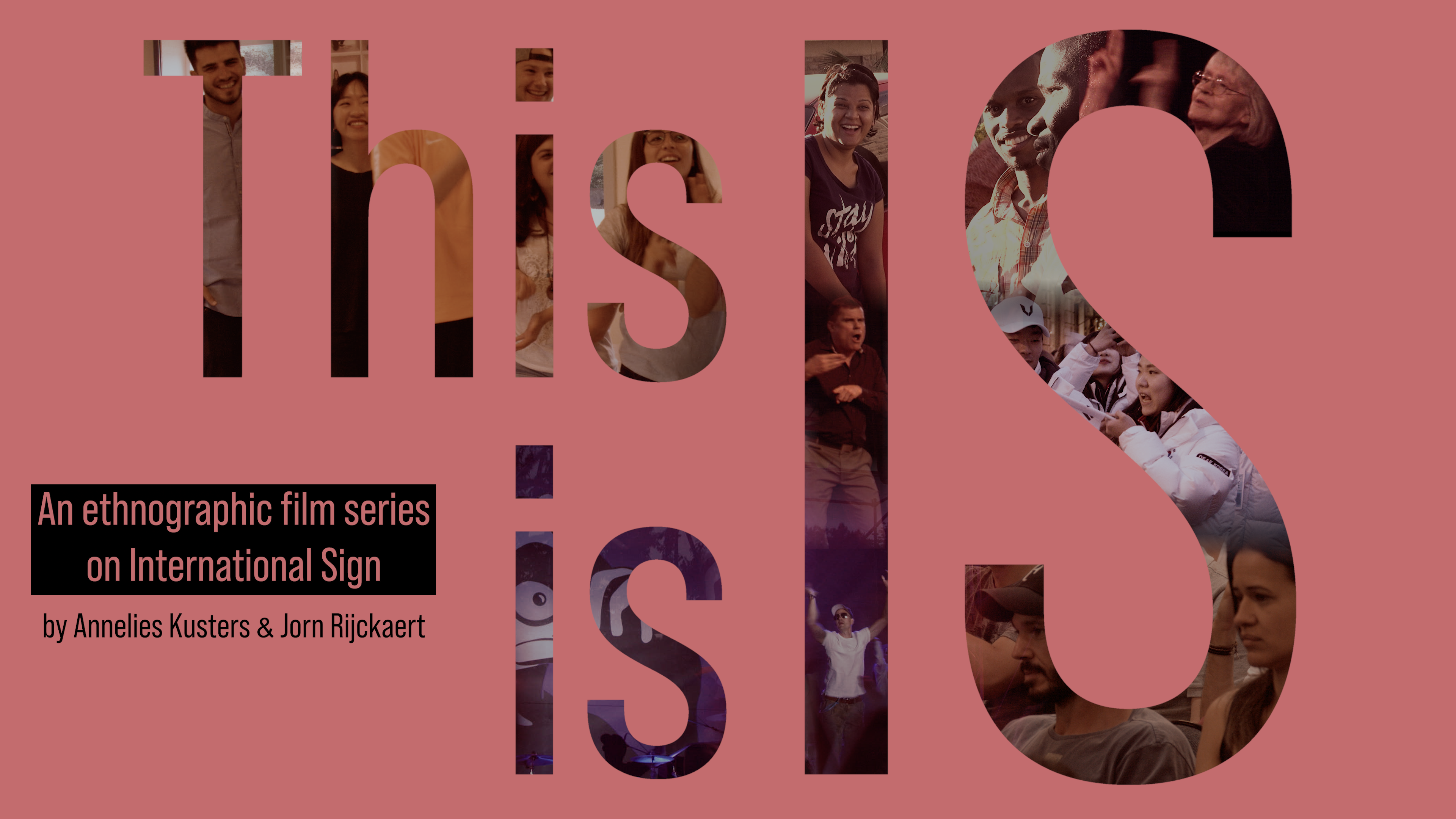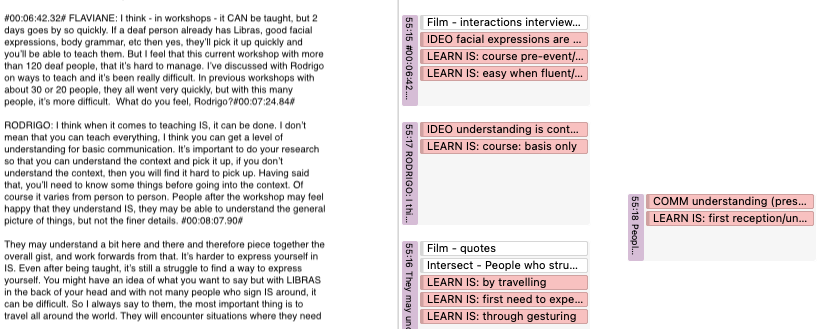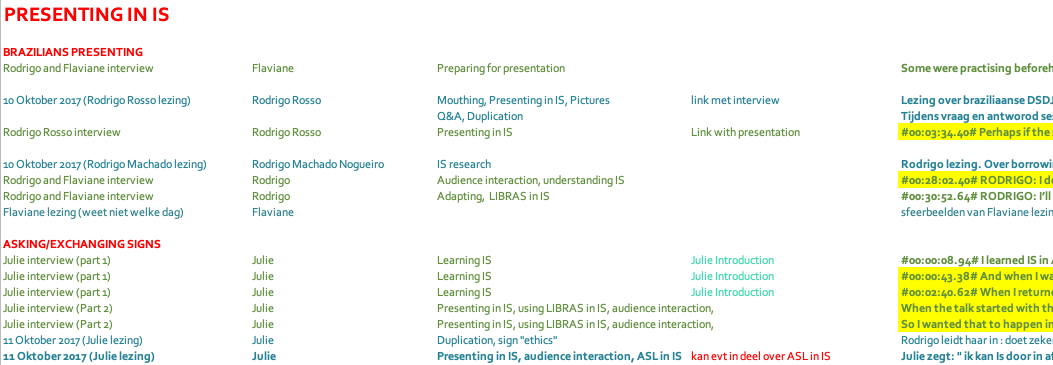“This is IS” is an ethnographic film series created by Annelies Kusters (researcher) and Jorn Rijckaert (camera and editor), consisting of six episodes on the practice and politics of International Sign (IS). It focuses on the uses of International Sign in the context of professional mobility, i.e. how students, teachers, translators, interpreters, performers, presenters, organisers and attendees use International Sign to interact across languages. This series engages with the following questions: What is International Sign? How do people learn it? Is International Sign a language? Should ASL signs be used in International Sign? How does IS work in the context of interpreting? What are the possible futures of International Sign?
This FAQ is a living document and more questions will be answered about the different episodes and about the film series in general. Please send any questions you have to a.kusters (at) hw.ac.uk. We are also very interested in learning how this film series is used in teaching: if you have discussed one or more episodes in a classroom, please get in touch!
What is each episode about?
Episode one: “International Sign Unpacked”: filmed in the Frontrunners course in Denmark, Europe, where a group of youth from all over the world studies in International Sign. The episode explores what IS is, and how its use changes over time in a group of people.
Episode two: “Is this International Sign?”: filmed in DOOR International, a deaf bible translation centre in Kenya, where deaf people from mostly African countries learn each other’s sign languages. The episode explores whether they call their multilingual signing “International Sign”.
Episode three: “International Sign Crash Course”: filmed at SIGN8, a sign language conference in Brazil, South America, where International Sign is used on the stage. The film explores whether IS can be learned in a matter of hours (in a pre-conference course) or days (the conference itself).
Episode four: “Is IS more visual?”: filmed at Clin d’Oeil, a deaf cultural festival in France, Europe. The film explores the possibilities and limits of IS signing in genres such as theatre, magic, stand-up comedy, visual vernacular (VV), and music, zooming in on rhythm and pace of signing. The episode explores whether IS is “more visual” than national sign languages, mime, and VV.
Episode five: “One Size Fits All?” (working title): filmed at the WASLI and WFD conferences in Paris, France. The episode shows that standardised forms of IS do not work for everyone. It considers whether interpreting between IS, English and national sign languages can fix these problems.
Episode six: “Easy Come, Easy Go?” (working title): filmed at the Winter Deaflympics in Italy. Deaf people have used IS in the sports world for more than a century, and the sports world is where many people think “pure IS” is used. As the episode shows, it is also the place where the continued use of IS is under threat as not all athletes and coaches know how to sign.
Should I watch the episodes in the correct order?
The six episodes build upon each other. The first episode sets the foundation for the other episodes, as some themes that are introduced in Episode One return in later episodes. Also, new themes are introduced in subsequent episodes. Watching the episodes in order will thus gradually provide you with different themes in relation to IS. But maybe you feel especially interested in the setting of one specific episode, such as having an interest in sports or an interest in IS interpreting? No problem, each episode was created to also stand on its own!
Does the series cover the full spectrum of IS use?
No, this series was created to study IS use within the theme of “professional mobility”, in settings where groups of deaf people from different nations gather and communicate in IS. “Professional mobility” is understood broadly here: deaf people come together based on commonalities such as sharing a profession, orientation, interest, mission, or passion. This includes higher education, conferencing, sports, performing and international workplaces. Professional mobility is a motivation to engage in international deaf interactions for professionals but also for others. Local hosts, teachers, and organisers make the events happen. Enthusiastic spectators travel to events for education, exchange, and entertainment. The focus is not only on “the professionals”, but on the holistic context of short-term gatherings around professional activities.
While this series’ focus is broad, it does not cover the full range of contexts in which IS is used. For example, not covered is the use of IS by deaf refugees who have just arrived in a new country, or the use of IS in the context of tourism (but the latter theme features in one of our other films!). This is IS was recorded pre-Covid and focused on in-person interactions. Online uses of IS (such as in Instagram TV and on Facebook) are not covered as a separate key setting. However, being aware of the importance of online uses of IS in the context of professional mobility, we tried to include it here and there. For example, Episode One includes scenes on online signing of IS. It shows that people who learned IS online experienced that the IS used at Frontrunners is different. The episode also zooms in on the theme of creating videos in IS for broad audiences.
How do you portray IS use in relation to diversity of deaf participants?
This is IS is designed to zoom in not only on very general themes in relation to IS, but also on how people’s diverse backgrounds and other factors shape the experience of socialising, presenting, and working in International Sign. When selecting protagonists, we took in mind factors such as previous experience with IS, nationality, race, educational background, age, disability, gender, LGBTQIA+ and so on. Being part of underrepresented and oppressed groups can lead to struggles with IS or to alternative uses of IS. Having existing networks is often a big help when immersing oneself in contexts where IS is used, as it gives access to informal interpreting or introductions to new people.
For example, Episode 1 explores how not being a European and not having previous knowledge of “European IS” impacts on participation in IS contexts. The non-European students must work harder to communicate with people and feel uncertain about asking for repetition. In Episode 2, based in Kenya, we show how it is more difficult for women to be included in this international space. In Episode 5, we consider the theme of being deafblind or deaf with physical disabilities at the WFD conference. In Episode 6 the topic of hearing status is explored, as the amount of people that are deaf, hard of hearing or hearing impacts on the extent to which IS is used at this event. It is important to keep in mind that not all diversity is visible: we have interviewees who do not disclose minoritized or oppressed identities in their interviews, such as not mentioning gender identity, sexual orientation, or disabilities.
A main theme in relation to MobileDeaf, is that we want to zoom in on encounters between people for whom international travel is possible, and people who meet deaf people from other countries mostly in their own country. For example, in Episode 3, we show that deaf Brazilians use IS with deaf non-Brazilians who visit their country. For some of them, this is the first experience with IS or with foreign sign languages.
(Episode One) How did you select the protagonists?
In September 2017, we filmed and interviewed ten of the seventeen Frontrunners students, and two of the four teachers. It was not possible to interview all students and teachers due to time constraints. Of the four teachers, two were selected: one newer, non-European teacher who was also a previous Frontrunner (Mark), and one European teacher who had worked in the programme for much longer (Outi). Our initial aim was to choose only six student protagonists, but we found it too hard to choose! We wanted to interview Frontrunners from all parts of the world and with various linguistic trajectories with regard to knowledge of IS, ASL and English. When we returned in May 2018 though, four people, including three of our chosen interviewees (from Togo, Belgium, and Czech Republic) had left the programme. This means they were not included as key protagonists, as the key purpose for this episode was to compare between people’s signing and opinions between September 2017 and May 2018.
(Episode One) What methods were used to study opinions about changes in IS signing?

In September, we filmed interactions between people, in the classroom and outside of the classroom. Annelies also organised interviews and a classroom discussion in which she asked about the nature of IS, and the role of features such as ASL, mouthings, fingerspelling and so on. In May, a series of other methods were added:
– Participatory filmmaking: The Frontrunners who study in the “media” track were asked to create one or more short clips on the theme: What is IS, and how has it changed? Their brainstorm and practice session were video-recorded too. Parts of the two clips they produced were included in the film, to show what the Frontrunners themselves highlighted of their experience with IS.
– Language portraits: These are empty body silhouettes where people can colour or write their languages and other forms of communication that are important to them. In the narratives explaining their language portraits, Frontrunners and their teachers reflected on their languages, including IS, in relation to their bodies and emotions.
– Lexicon: We showed English terms to the interviewed Frontrunners and their teachers and asked what signs they would use with the Frontrunners. Not all participants recognised each English word. In the film we only used terms that were correctly recognised. The aim was to study people’s reflections on the signs they would pick or avoid to use, such as ASL signs, and the selection of the Catalan signs for “AGREE” and “DISAGREE”.
– Retrospective interviews and classroom discussion: The Frontrunners watched the interviews Annelies had done with them in September, and a montage of the September recordings of interactions in the group. They commented, in interviews and in group discussions, on how their signing and their opinions had changed.
(Episode One) How did the editor work with the video materials created through these different methods?
As explained above, there were a lot of different methods in use to study International Sign in the Frontrunners group, which led to an enormous number of recordings. It was challenging to organize aspects of all these materials within a coherent film with an acceptable length. Cameraman and editor Jorn had some visual strategies to tie the September 2017 and May 2018 recordings together. In September, each interviewee was interviewed with a different background, and in May, each person was interviewed with the same background as in September. In May, the person would sit a bit to the right of where they sat in September (and sometimes, plants were subtly repositioned too!). Fortunately, the design of these spots had not changed in those eight months! Interviewees sitting in these slightly different positions helped to make it clearer for the audience which images were from September and which images were from May. In the end, some of the September quotes were moved to the May part of the film, to function as flashbacks – these flashbacks also formed the transition between the first (September) and second (May) part of the film.

To create a coherent story, Jorn worked with a storyboard with printed quotes from interviews and accompanying photos of these moments in the film. There were challenges in the organization of themes, such as the timeline of events. Some of the Frontrunners arrived the day before the others, so the images of other Frontrunners could not be used in the first chapter of the film. Also, examples from September could not be mixed up in the May part (apart from the flashbacks). The language portraits and elicitation of lexicon were part of Annelies’ research but were not initially planned to be included in the film. However, when creating the film, we found it interesting to include them after all. Fortunately, for the recording of these parts, the participants sat in the same spot as during their interviews, and the drawing of language portraits was filmed in full. It was a long and difficult process to combine all the different types of recordings, which made Episode One the most complex to edit, but we felt a multidimensional introduction to IS was right to start This is IS.
Questions for discussion
These are sample questions to discuss when using the films in a classroom.
Episode One: International Sign Unpacked
- What is International Sign?
- In what way does successful communication in IS rely on shared cultural frameworks?
- Does online IS learning prepare people for using IS face to face?
- When does fingerspelling help, and when doesn’t it help?
- When does mouthing help, and when doesn’t it help?
- What are some potential issues with facial expressions in IS?
- “Visual signing” or “gesturing” is described as crucial and core to IS, but it also takes more time. How does this impact its use in IS?
- How are fingerspelling, mouthing, the use of Google Translate, writing on a board, and text on PPTs linked to each other for understanding?
- What are the various reasons to use or not use ASL in IS?
- How does IS change over time in a group?
- Is IS use in the group less diverse at the end of the course, or is it more diverse? In what ways?
- Did students converge on their use of ASL in IS?
- How do the students support each other’s learning?
- In what ways do some participants have a head start over others in terms of IS use?
- How do the teachers try to steer the students’ signing, and to what extent?
- Do you note examples of racism, language shaming, and linguicism?
- Is there consistency between what people say about ASL, and how they treat ASL?
- How are misunderstandings, adaptations, repairs and exchanges of different signs reflected in different styles of subtitling (or not subtitling) throughout the film?
- At the end of the course, is IS treated as a language like other sign languages?
- What different styles or types of IS (and their audiences) do the students distinguish between by the end of their course?
Episode Two: Is this International Sign?
- How are the concepts “international”, “international people” and “International Sign” used by the people in the film? What/who do these concepts refer to? How is this in contrast with the meanings of the concepts in Episode 1?
- What are responses towards ASL and feelings about ASL among the people interviewed for this film, and how are these associated with the history of ASL in Africa?
- What is the perceived function of ASL in international encounters within Africa and with non-Africans?
- What is the perceived function of KSL in international encounters within Africa and with non-Africans?
- In the DOOR campus, there are spaces to separate languages, and spaces to calibrate (or mix) languages: explain?
- Are people able to keep sign languages strictly separate in contexts of translation work? What are strategies to keep sign languages separate?
- How does a long period of collaboration between India and Kenya influence signing in Kenya and the translation work in Kenya?
- Would you call the mix of sign languages that people use, and the strategies they employ in international signed communication, “International Sign”? Why or why not?









